Hospital Referral Letter
[Your Name]
[Your Title/Position]
[Your Department]
[Your Hospital/Clinic Name]
[Address]
[City, State, ZIP Code]
[Email Address]
[Phone Number]
[Date: Month Day, Year]
[Recipient's Name]
[Recipient's Title/Position]
[Recipient's Hospital/Clinic Name]
[Address]
[City, State, ZIP Code]
Subject: Referral for Patient: [Patient's Full Name], [Patient's Date of Birth]
Dear Dr./Mr./Ms. [Recipient's Last Name],
I hope this letter finds you well. I am writing to refer my patient, [Patient's Full Name], for further evaluation and management of their medical condition. As part of our collaborative effort to provide the best possible care, I am seeking your expert opinion and assistance in addressing the specific healthcare needs of this patient.
Patient Information:
- Name: [Patient's Full Name]
- Date of Birth: [Patient's Date of Birth]
- Gender: [Patient's Gender]
- Medical Record Number: [Patient's MRN, if applicable]
- Diagnosis/Condition: [Brief description of the patient's diagnosis/condition]
- Relevant Medical History: [Brief summary of the patient's medical history]
Clinical Findings and Reasons for Referral:
[Provide a detailed overview of the patient's clinical presentation, diagnostic findings, and reasons for the referral. Highlight any specific concerns, test results, or treatment approaches that have led to the decision to refer the patient.]
Requested Evaluation and Management:
[Specify the services, tests, consultations, or procedures you are requesting from the recipient. Be clear about the objectives and goals of the referral, and any specific questions you would like the recipient to address.]
Current Medications:
[List the patient's current medications, dosages, and any relevant details about ongoing treatments.]
I would greatly appreciate your prompt attention to this referral. Please keep me informed about the evaluation, findings, and treatment plan for this patient. I am open to further discussion and collaboration regarding their care.
Please do not hesitate to contact me via email at [Your Email Address] or by phone at [Your Phone Number] if you require any additional information or have questions about this referral.
Thank you for your dedication to patient care and your ongoing collaboration. I am confident that your expertise will greatly contribute to the well-being of [Patient's Full Name].
Sincerely,
[Your Signature]
[Your Typed Name]
[Your Title/Position]
[Your Hospital/Clinic Name]
[Your Contact Information]
Enclosure: [Optional: List any relevant documents or reports enclosed with the referral letter]
---
Note: This template is a general guideline and can be customized to fit the specific requirements and practices of your hospital or clinic. Make sure to review and modify the content as necessary before sending it.
General Hospital Referral Letter
Subject: Referral for Further Medical Evaluation
Dear Dr. [Recipient's Name],
I am referring my patient, [Patient Name], who has been under my care for [Condition/Reason]. Despite our ongoing management, the patient requires specialized evaluation and treatment that can be provided at your facility.
Attached are the patient’s medical records, recent lab results, and imaging reports. I kindly request your assessment and recommendations for further management.
Thank you for your attention to this matter.
Sincerely,
[Your Name]
[Your Position]
[Your Contact Information]
Emergency Referral Letter
Subject: Urgent Referral for Emergency Care
Dear Dr. [Recipient's Name],
I am sending this letter to urgently refer [Patient Name], a [Patient Age]-year-old patient experiencing [symptoms, e.g., chest pain, severe shortness of breath]. Immediate evaluation and intervention are necessary.
Please find attached vital signs, preliminary investigations, and any ongoing treatments. Your urgent attention to stabilize and manage the patient is highly appreciated.
Thank you for your prompt action.
Best regards,
[Your Name]
[Your Position]
[Contact Details]
Pediatric Referral Letter
Subject: Pediatric Referral for Specialized Care
Dear Dr. [Recipient's Name],
I am referring my pediatric patient, [Child's Name], aged [Age], for further assessment regarding [condition, e.g., recurrent infections, developmental concerns]. Current management has not achieved the desired outcomes.
Enclosed are growth charts, immunization records, and recent laboratory results. Your expert evaluation and recommendations are requested.
Thank you for your attention.
Warm regards,
[Your Name]
[Your Position]
[Contact Information]
Specialist Referral Letter
Subject: Referral to Specialist for Advanced Care
Dear [Specialist's Name],
I am referring my patient, [Patient Name], for specialized evaluation in [field, e.g., cardiology, neurology]. The patient presents with [brief description of symptoms or diagnosis] requiring advanced diagnostic or therapeutic interventions.
Please find attached relevant test results, imaging reports, and medical history. Your assessment and management recommendations would be highly valuable.
Thank you for your cooperation.
Sincerely,
[Your Name]
[Your Position]
[Contact Information]
Preliminary Referral Letter
Subject: Preliminary Referral for Evaluation
Dear Dr. [Recipient's Name],
This letter serves as a preliminary referral for my patient, [Patient Name], who requires evaluation for [condition or symptom]. We have initiated basic investigations and management but believe specialized input is necessary.
Attached are initial test results and patient history. Please advise on further investigations or treatment plans.
Thank you in advance for your guidance.
Kind regards,
[Your Name]
[Your Position]
[Contact Information]
Follow-up Referral Letter
Subject: Follow-up Referral for Continued Care
Dear Dr. [Recipient's Name],
I am referring [Patient Name] for follow-up evaluation regarding [condition]. The patient previously received care at your facility, and ongoing management requires your continued oversight.
Attached are recent progress notes, laboratory results, and medication updates. Please provide further recommendations for care continuation.
Thank you for your support.
Sincerely,
[Your Name]
[Your Position]
[Contact Information]
Diverted Referral Letter
Subject: Referral Redirection for Specialized Treatment
Dear Dr. [Recipient's Name],
Due to recent developments, [Patient Name] requires care that falls under your specialty. I am redirecting the referral to your department for evaluation and management.
Please find attached prior assessments and treatment summaries. Your expertise in handling this case is appreciated.
Kind regards,
[Your Name]
[Your Position]
[Contact Information]
What is a Hospital Referral Letter and Why It Is Needed
A hospital referral letter is a formal communication from one healthcare provider to another, requesting specialized evaluation or treatment for a patient.
Reasons for sending a referral letter include:
- Patient requires specialized care not available at the referring facility.
- Escalation of treatment due to worsening or persistent symptoms.
- Continuity of care between healthcare providers.
- Administrative documentation for insurance or hospital records.
- Coordination for diagnostic tests or surgical procedures.
Who Should Send a Hospital Referral Letter
- General practitioners referring patients to specialists.
- Pediatricians or family doctors managing ongoing care.
- Hospital physicians transferring patients to higher-level facilities.
- Nurses or medical assistants under physician supervision in formal contexts.
Whom Should the Referral Letter Be Addressed To
- Specialists in the field of concern (cardiologist, neurologist, pediatrician).
- Hospital admission departments when transferring a patient.
- Emergency or critical care units in urgent cases.
- Administrative officers handling medical records for inter-hospital transfers.
When Should a Hospital Referral Letter Be Written
- Upon detection of a condition requiring specialized care.
- When initial management does not improve patient condition.
- For scheduled or routine specialist assessments.
- During emergency scenarios requiring urgent hospital attention.
- Prior to transferring a patient to a tertiary care center.
How to Write and Send a Hospital Referral Letter
- Clearly state the purpose in the subject line.
- Provide patient information concisely: name, age, diagnosis, relevant history.
- Include attachments: lab results, imaging, medication list.
- Use professional or formal tone depending on context.
- Send via secure channels: email for digital referrals, printed letter for formal transfers.
- Confirm receipt and follow-up instructions.
How Many Attachments or Documents Should Accompany the Letter
- Minimum: recent lab reports, imaging results, and progress notes.
- Optional: previous referral letters, medication history, growth charts (for pediatric patients).
- Ensure completeness to avoid delays in evaluation or treatment.
Frequently Asked Questions (FAQ)
Q: Can a referral letter be sent by email?
A: Yes, secure email is acceptable, especially for preliminary or routine referrals.
Q: How long should a referral letter be?
A: Typically one page; concise but informative.
Q: Is patient consent required?
A: Yes, patient consent is necessary before sharing medical information.
Q: Can non-physicians write the referral letter?
A: Only under supervision and with proper authorization.
Requirements and Prerequisites Before Sending a Hospital Referral Letter
- Confirm diagnosis and reason for referral.
- Obtain patient consent for sharing records.
- Gather complete medical documentation.
- Ensure the receiving specialist is available and appropriate.
- Check insurance or administrative requirements if applicable.
Formatting Guidelines for Hospital Referral Letters
- Length: 1 page is preferred.
- Tone: Professional, clear, and polite; urgent cases require concise urgency.
- Style: Structured with subject, greeting, body, closing, and attachments list.
- Mode: Email for digital transfer, printed letter for official or legal purposes.
- Etiquette: Avoid excessive medical jargon; provide sufficient context.
After Sending a Hospital Referral Letter / Follow-up
- Confirm receipt of the letter with the receiving facility.
- Provide additional documents if requested.
- Follow up on recommendations or scheduled appointments.
- Document communication in patient records for continuity of care.
Pros and Cons of Sending a Hospital Referral Letter
Pros:
- Ensures continuity of care.
- Provides legal and administrative documentation.
- Facilitates specialized treatment.
Cons:
- Delays if the letter is incomplete or unclear.
- Risk of miscommunication if attachments are missing.
- May require repeated follow-ups to confirm receipt.
Compare and Contrast Referral Letters with Other Communication Methods
- Compared to phone calls: letters provide a permanent record, more detailed context.
- Compared to email: letters may be required for official or legal purposes.
- Alternative: electronic referral systems integrated with hospital records for speed and tracking.
Tricks and Tips for Writing Effective Hospital Referral Letters
- Include concise patient summary and relevant history.
- Highlight urgency or priority clearly.
- Attach all relevant documents to prevent back-and-forth.
- Use bullet points for key findings when necessary.
- Double-check spelling, names, and contact information.
Common Mistakes to Avoid
- Omitting vital patient information or test results.
- Using ambiguous language or abbreviations.
- Failing to obtain patient consent.
- Sending to the wrong specialist or facility.
- Ignoring formatting and professional tone.
Essential Elements and Structure of a Hospital Referral Letter
- Subject line specifying referral reason.
- Salutation addressing the recipient.
- Patient identification and brief medical summary.
- Reason for referral and urgency.
- List of attachments or supporting documents.
- Closing with signature and contact information.
Does a Hospital Referral Letter Require Authorization?
- In most cases, yes: patient consent is mandatory.
- Some facilities may require attestation from the referring physician or hospital seal.
- Authorization ensures legal compliance and patient privacy protection.

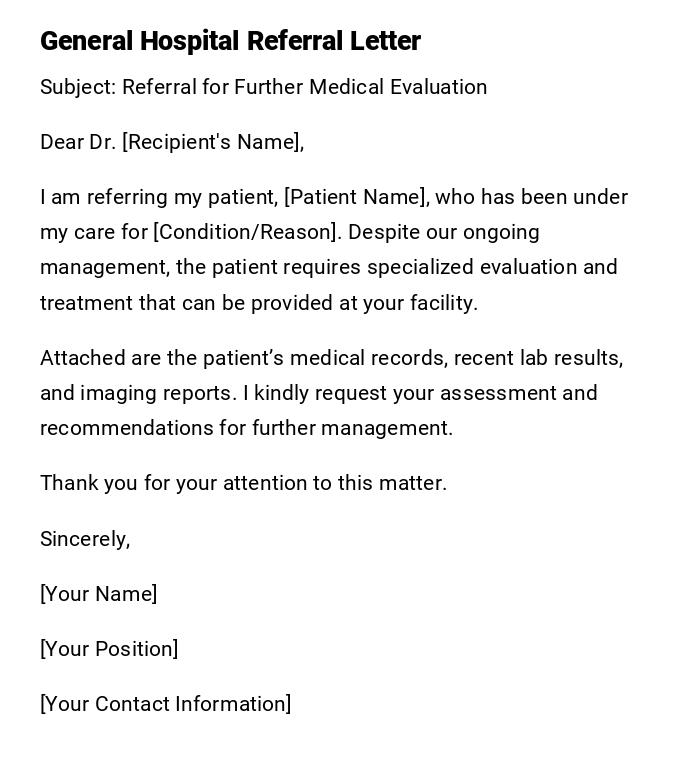
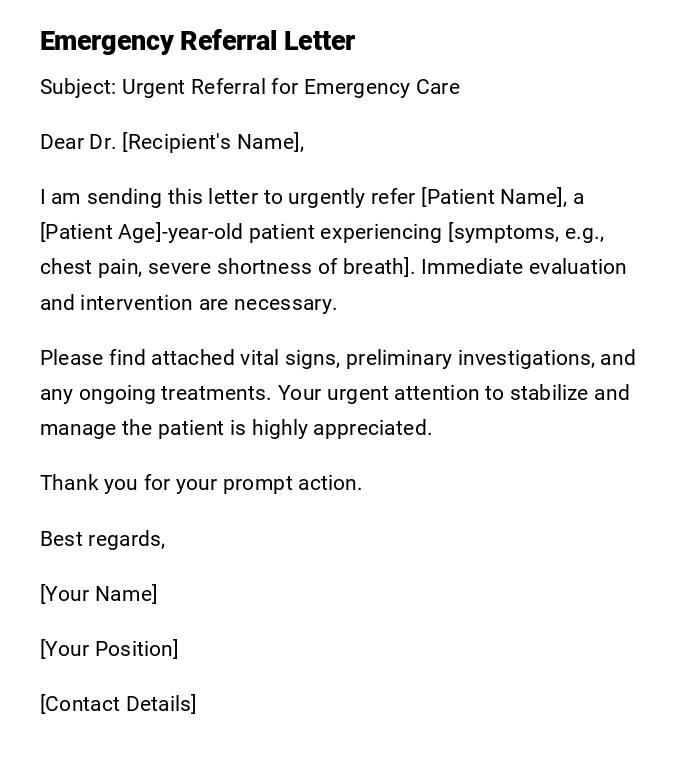
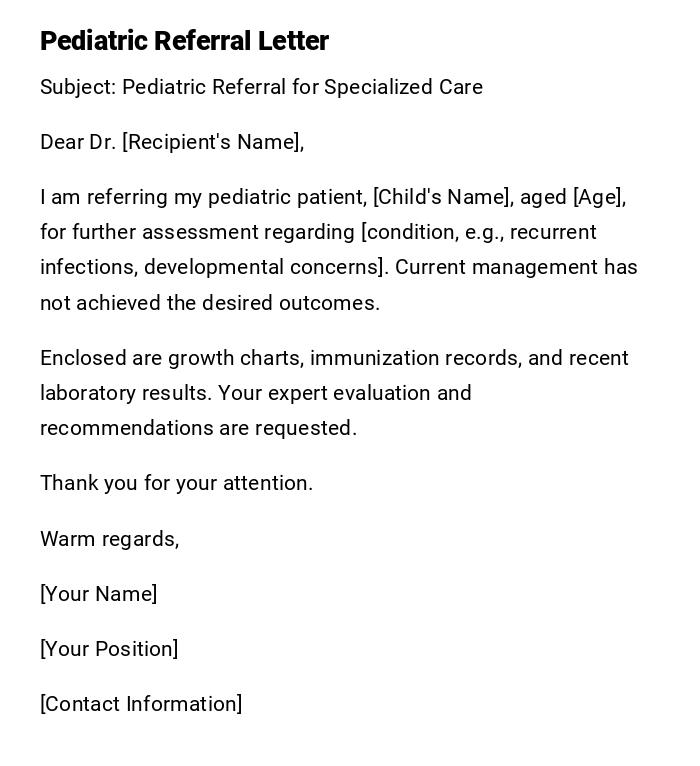
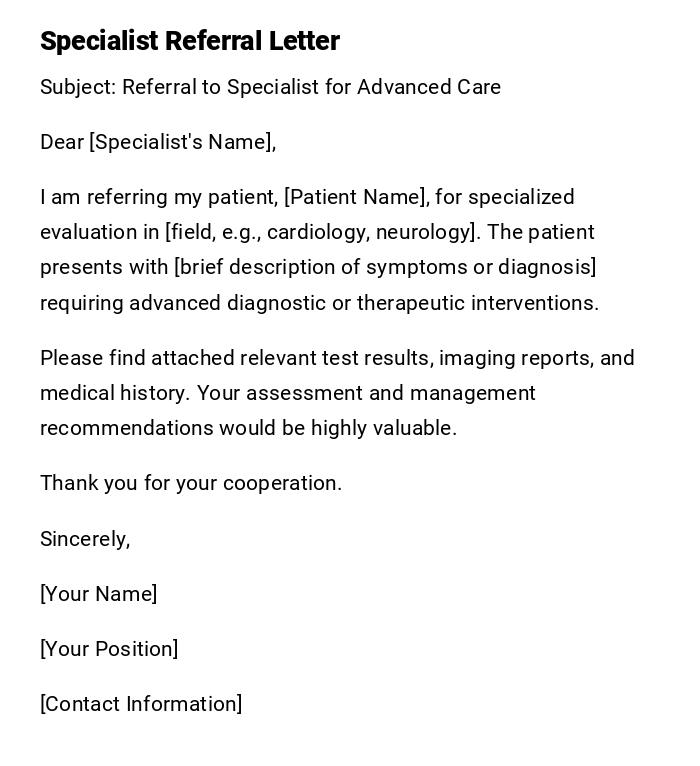
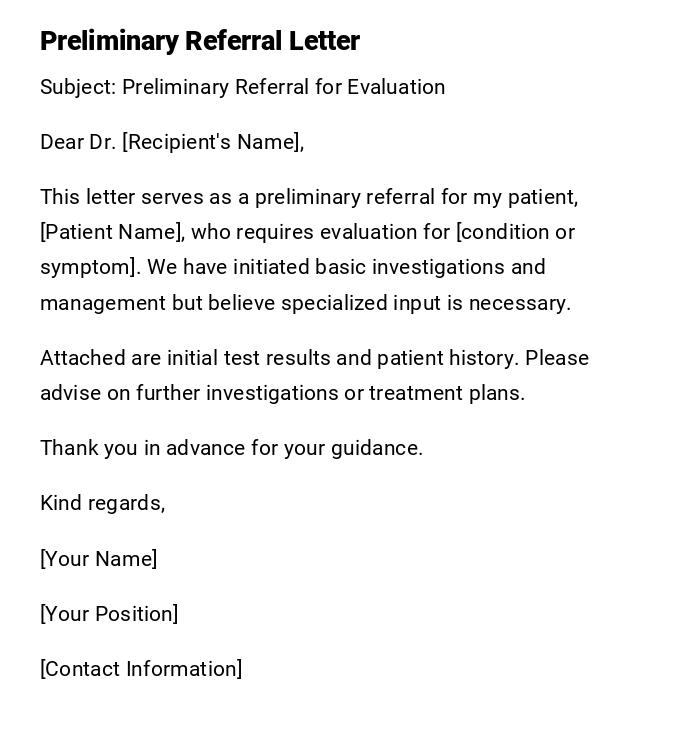
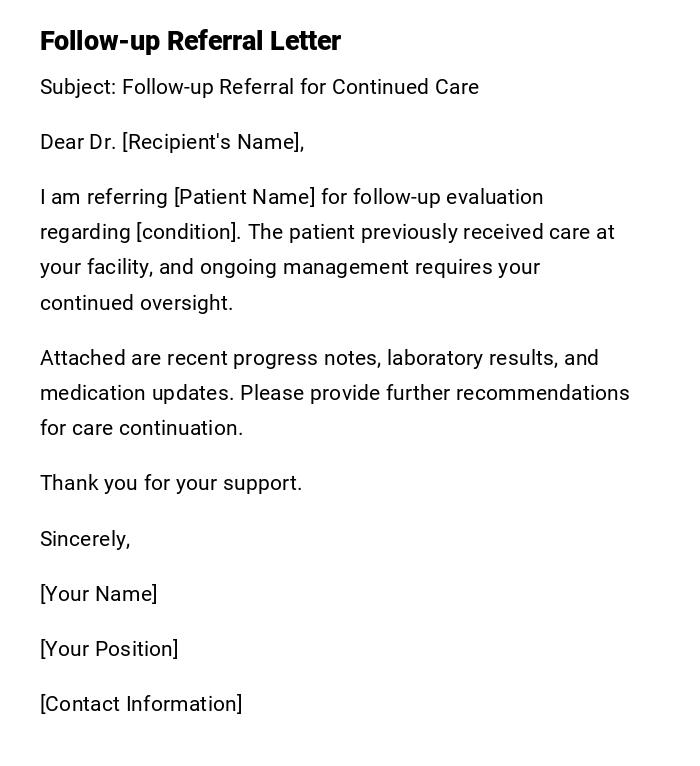
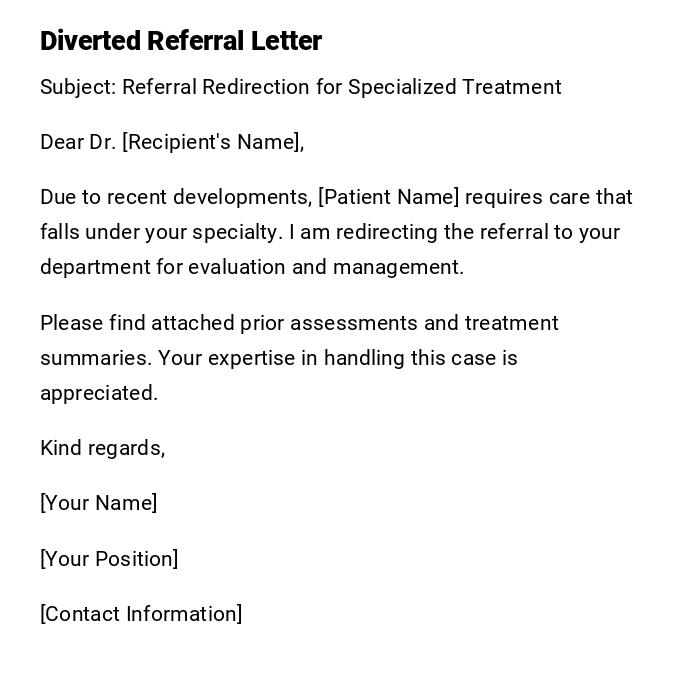

 Download Word Doc
Download Word Doc
 Download PDF
Download PDF